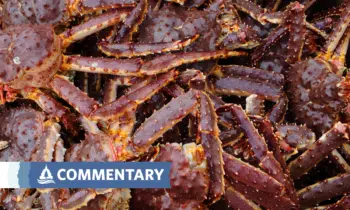 The Bering Sea red king crab once supported one of the most productive fisheries on the planet. Then, the fishery suddenly imploded and presently limps along at an average harvest level of less than 2% of the 1980 pre-collapse harvest of 130 million pounds.
The Bering Sea red king crab once supported one of the most productive fisheries on the planet. Then, the fishery suddenly imploded and presently limps along at an average harvest level of less than 2% of the 1980 pre-collapse harvest of 130 million pounds.
In response to one of its own experts’ documented contention that the collapse was due to overfishing, NOAA replied that the primary causative factor was warming seas caused by climate change. A new NOAA study puts the lie to that alibi.
As reported in the February 25th edition of the Kodiak Daily Mirror a study by Kodiak’s NOAA scientists found ocean acidification was a factor in the Bering Sea red king crab decline. The scientists determined that “approximately one-fifth” (20%) of the recruitment failure since 1980 was the result of a (model-estimated) increase in bottom seawater acidity, from a pH of 8.03 to 7.89.
Notably, the scientists found that water temperature had no role in the failing recruitment of Bering Sea red king crab. This conclusion refutes the long-held but poorly verified NOAA opinion that the post-1980 collapse was the result of a meteorological “regime shift” accompanied by warming seas.
The finding that seawater temperatures were of little concern to red king crabs should have surprised no one familiar with the literature. In 2008, Russian scientists (Matishov et al.) reported that all red king crabs survived an experiment where the crabs were switched from -2 C (28.4 F) water to 14 C (57.2 F) water (and vice-versa) with no acclimation. All of the Arctic sculpin included in the experiment died within five minutes.
More than 40 years after the near eradication of Alaska’s premier shellfish fishery, we should expect more than an explanation of a mere 20% of the factors behind the collapse. The problem is that NOAA/NMFS scientists prefer to focus on climate change and ocean acidity, which are natural-mortality factors over which they have no control and for which they can escape blame. Government science assiduously avoids any discussion of trawling and its massive incidental bycatch, which represents the bulk of the damage to the fish and crab stocks of Alaska. NOAA/NMFS might be more productive by managing Alaska’s fishery resources rather than trying to manage the narrative that large-scale trawling is “sustainable”.
Twenty years ago, NOAA scientists using NMFS’ own data showed that trawling explained up to 60% (three-fifths) of the decline of the Bering Sea red king crab female broodstock during 1975-1987 (Dew and McConnaughey, p.931). However, in their new study, NOAA scientists not only avoided any mention of man’s fishing, including trawling, but they also pointedly failed to cite the Dew and McConnaughey paper, which is an exhaustive study of the role of fishing mortality, especially trawl-bycatch mortality, in the post-1980 collapse of Bering Sea red king crab.
Furthermore, based on the concept of age-specific reproductive value, it is relevant that killing a given proportion of mature, egg-bearing broodstock by trawling is infinitely more damaging to recruitment than acidity killing the same proportion of prepubescent crabs, most of which will die naturally before contributing to recruitment.

Contents of a U.S.-Soviet Joint-Venture red bag delivered by an American trawler to the Russian processor, Chasovoy. Photo by Doug Smith, former NMFS observer.
Trawling is obviously a dominant source of red king crab mortality. The photo below shows the contents of a “red bag” (a trawl cod-end full of red king crab) delivered by a domestic trawler to the Soviet processor Chasovoy in late August 1981. According to the observer’s logbook, this catch and several more like it (predominantly egg-bearing females) were taken from a water depth of 55-75 m during August-September off Black Hill in the previously un-trawled Japanese Broodstock Sanctuary.
Because of an inadequate, NMFS-designed observer program, trawl catches full of prohibited-species bycatch were not counted or measured before being discarded. The scene depicted here, reported as commonplace during the early years of the Soviet-American joint-venture trawling, suggests how quickly the reproductive capacity of Bering Sea red king crabs might have been eroded, while observer-estimated “official” bycatch numbers remained deceptively low.
Dew, C.B., and R.A. McConnaughey. 2005. Did trawling on the brood stock contribute to the collapse of Alaska’s king crab? Ecol. Appl. 15:919-941. doi:10.1890/03-5231 NOAA Ducks Responsibility in Alaska King Crab Collapse
Litzow M.A., W.C. Long, K.J. Palof, and D.J. Pilcher. 2025. Ocean acidification may contribute to recruitment failure of Bering Sea red king crab. Canadian Journal of Fisheries and Aquatic Sciences, Vol. 82.
 Dr. C. Braxton Dew is a fisheries biologist with more than 40 years of experience, 25 of which were with NOAA Fisheries. You can read more about this issue here and here.
Dr. C. Braxton Dew is a fisheries biologist with more than 40 years of experience, 25 of which were with NOAA Fisheries. You can read more about this issue here and here.